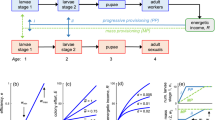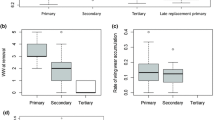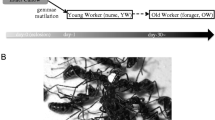Abstract
In temperate regions, older eusocial hymenopteran females with annual life cycles (annual-temperate) tend to dominate younger females, a behavior demonstrated by many Polistes. However, in queenless ponerine ants and primitively eusocial tropical wasps (perennial/tropical), a younger female can be dominant and occasionally takes over from the older, most dominant reproductive female, the alpha. We investigated these patterns using an inclusive fitness model. The most important difference between the above two cases lay in the length of individual life compared with colony life. Colonies dissolve before winter in the annual-temperate case, so the expected future tenure of the replacement alpha is never longer than that of the original alpha. This makes the non-reproductive subordinate tactic more advantageous for individuals that emerge later in the season because of the fitness cost of superseding. The perennial/tropical case does not have a clear upper limit for colony longevity, so the model predicts that late-born younger daughters are more likely to challenge their mother-alpha because of the expected long future tenure of the new alpha compared with the small indirect cost of the mother’s reproductive failure. To switch tactics from being a subordinate to being the new alpha is only optimal in some situations. The high mortality rate of subordinate workers does not qualitatively alter the above pattern. The specific sexual production schedule of the colony sometimes affects the optimal behavior of females in the perennial/tropical case, and older individuals can dominate younger ones when the end of current round of sexual production is imminent.






Similar content being viewed by others
References
Bourke AFG, Franks NR (1995) Social evolution in ants. Princeton University Press, Princeton, N.J.
Cole BJ (1981) Dominance hierarchies in Leptothorax ants. Science 212:83–84
Cuvillier-Hot V, Cobb M, Malosse C, Peeters C (2001) Sex, age and ovarian activity affect cuticular hydrocarbons in Diacamma ceylonense, a queenless ant. J Insect Physiol 47:485–493
Dew HE, Michener CD (1981) Division of labor among workers of Polistes metricus (Hymenoptera: Vespidae): laboratory foraging activities. Insect Soc 28:87–101
Dewsbury DA (1982). Dominance rank, copulatory behavior and differential reproduction. Q Rev Biol 57:135–159
Enquist M, Leimar O (1983) Evolution of fighting behaviour: decision rules and assessment of relative strength. J Theor Biol 102:387–410
Franks NR, Scovell E (1983) Dominance and reproductive success among slave-making worker ants. Nature 304:724–725
Fukumoto Y, Abe T, Taki A (1989) A novel form of colony organization in the “queenless” ant Diacamma rugosum. Physiol Ecol Jpn 26:55–61
Gadagkar R (1980) Dominance hierarchy and division of labour in the social wasp Ropalidia marginata (Lep.) (Hymenoptera: Vespidae). Curr Sci 49:772–775
Gadagkar R (1989) Belonogaster, Mischocyttarus, Parapolybia, and independent-founding Ropalidia. In: Ross KG, Matthews RW (eds) The social biology of wasps. Comstock, Cornell University Press, Ithaca, N.Y., pp 149–190
Gadagkar R (2001) The social biology of Ropalidia marginata. Harvard University Press, Cambridge, Mass.
Gobin B, Billen J, Peters C (2001) Dominance interactions regulate worker mating in the polygynous ponerine ant Gnamptogenys menadensis. Ethology 107:495–508
Hamilton WD (1964) The genetical evolution of social behaviour. I, II. J Theor Biol 7:1–52
Heinze J (1993) Queen-queen interactions in polygynous ants. In: Keller L (ed) Queen number and sociality in insects. Oxford University Press, Oxford, pp 334–361
Higashi S, Ito F, Sugiura N, Ohkawara K (1994) Worker’s age regulates the linear dominance hierarchy in the queenless ponerine ant, Pachycondyla sublaevis (Hymenoptera: Formicidae). Anim Behav 47:179–184
Hölldobler B, Carlin NF (1985) Colony founding, queen control and oligogyny in the Australian meat ant Iridomyrmex purpureus. Behav Ecol Sociobiol 18:45–58
Hughes CR, Strassmann JE (1988) Age is more important than size in determining dominance among workers in the primitively eusocial wasp, Polistes instabilis. Behaviour 107:1–15
Ito Y (1993) Behaviour and social evolution of wasps: the communal aggregation hypothesis. Oxford University Press, Oxford
Ito F, Higashi S (1991) A linear dominance hierarchy regulating reproduction and polyethism of the queenless ant Pachycondyla sublaevis. Naturwissenschaften 78:80–82
Jeanne RL (1972) Social biology of the neopropical wasp Mischocyttarus drewseni. Bull Mus Comp Zool 144:63–150
Jeanne RL (1991) The swarm-founding Vespidae. In: Ross KG, Matthews RW (eds) The social biology of wasps. Comstock, Cornell University Press, Ithaca, N.Y., pp 191–231
Keller L (1998) Queen lifespan and colony characteristics in ants and termites. Insect Soc 45:235–246
Keller L, Passera L, Suzzoni JP (1989) Queen execution in the Argentine ant Iridomyrmex humilis (Mayer). Physiol Entomol 14:157–163
Kikuta N, Tsuji K (1999) Queen and worker policing in the monogynous and monandrous ant, Diacamma sp. Behav Ecol Sociobiol 46:180–189
Liebig J (1998) Eusociality, female caste specialization, and regulation of reproduction in the ponerine ant Harpegnathos saltator Jerdon. PhD thesis, Würzburg University, Berlin
Little M (1979) Mischocyttarus flavitarsis in Arizona: social and nesting biology of a polistine wasp. Z Tierpsychol 50:282–312
Maynard-Smith J (1982) Evolution and the theory of games. Cambridge University Press, Cambridge
Maynard-Smith J, Parker GA (1976) The logic of asymmetric contests. Anim Behav 24:159–175
Michener CD (1974) The social behavior of the bees. Harvard University Press, Cambridge, Mass.
Miyano S (1983) Number of offspring and seasonal changes of their body weight in a paperwasp, Polistes chinensis antennalis Perez (Hymenoptera: Vespidae), with reference to male production by workers. Res Popul Ecol 25:198–209
Miyano S (1986) Colony development, worker behavior and male production in orphan colonies of a Japanese paper wasp, Polistes chinensis antennalis Pérez (Hymenoptera: Vespidae). Res Popul Ecol 28:347–361
Miyano S (1990) Number, larval durations and body weights of queen-reared workers of a Japanese paper wasp, Polistes chinensis antennalis (Hymenoptera, Vespidae). Nat Hist Res 1:93–97
Monnin T, Peeters C (1999) Dominance hierarchy and reproductive conflicts among subordinates in a monogynous queenless ant. Behav Ecol 10:323–332
Monnin T, Ratnieks FLW (1999) Reproduction versus work in queenless ants: when to join a hierarchy of hopeful reproductives? Behav Ecol Sociobiol 46:413–422
Nakata K, Tsuji K (1996) The effect of colony size on the conflict over male-production between gamergate and dominant workers in the ponerine ant Diacamma sp. Ethol Ecol Evol 8:147–156
Oster GF, Wilson EO (1978) Caste and ecology of social insects. Princeton University Press, Princeton, N.J.
Pardi L (1948) Dominance order in Polistes wasps. Physiol Zool 21:1–13
Peeters C, Higashi S (1989) Reproductive dominance controlled by mutilation in the queenless ant Diacamma australe. Naturwissenschaften 76:177–180
Peeters C, Liebig J, Hölldobler B (2000) Sexual reproduction by both queens and workers in the ponerine ant Harpegnathos saltator. Insect Soc 47:325–332
Queller DC, Peters JM, Solís CR, Strassmann JE (1997) Control of reproduction in social insevt colonies: individual and collective relatedness preference in the paper wasp, Polistes annularis. Behav Ecol Sociobiol 40:3–16
Reeve HK (1991) Polistes. In: Ross KG, Matthews RW (eds.) The social biology of wasps. Comstock, Cornell University Press, Ithaca, N.J., pp 99–148
Reeve HK, Gamboa GJ (1983) Colony activity integration in primitively eusocial wasps: the role of the queen (Polistes fuscatus, Hymenoptera: Vespidae). Behav Ecol Sociobiol 13:63–74
Reeve HK, Ratnieks FLW (1993) Queen-queen conflicts in polygynous societies: mutual tolerance and reproductive skew. In: Keller L (ed) Queen number and sociality in insects. Oxford University Press, Oxford, pp 45–85
Reeve HK, Peters JM, Nonacs P, Starks PT (1998a) Dispersal of first “workers” in social wasps: causes and implications of an alternative reproductive strategy. Proc Natl Acad Sci USA 95:13737–13742
Reeve HK, Emlen ST, Keller L (1998b) Reproductive sharing in animal societies: reproductive incentives or incomplete control by dominant breeders? Behav Ecol 9:267–248
Seppä P, Queller DC, Strassmann JE (2002) Reproduction in foundress associations of the social wasp, Polistes carolina: conventions, competition, and skew. Behav Ecol 14:531–541
Strassmann JE (1981) Evolutionary implications of early male and satellite nest production in Polistes exclamans colony cycles. Behav Ecol Sociobiol 8:55–64
Strassmann JE, Meyer DC (1983) Gerontocracy in the social wasp, Polistes exclamans. Anim Behav 31:431–438
Suzuki T (1998) Paradox of worker reproduction and worker mating in temperate paper wasps, Polistes chinensis and P. senelleni (Hymenoptera Vespidae). Ethol Ecol Evol 10:347–359
Suzuki T (2003) Queen replacement without gerontocracy in the paper wasp Parapolybia indica in temperate Japan. Ethol Ecol Evol 15:191–196
Tsuji K, Tsuji N (1996) Evolution of life history strategies in ants: variation in queen number and mode of colony founding. Oikos 76:83–92
Van Honk CGJ, Röseler PF, Velthuis HHW, Hoogeveen JC (1981) Factors influencing the egg laying of workers in a captive Bombus terrestris colony. Behav Ecol Sociobiol 9:9–14
Vehrencamp SL (1983) A model for the evolution of despotic versus egalitarian societies. Anim Behav 31:667–682
West-Eberhard MJ (1969) The social biology of polistine wasps. Mis Publ Mus Zool Univ Mich 140:1–140
West-Eberhard MJ (1978) Temporary queens in Metapolybia wasps: non-reproductive helpers without altruism. Science 200:441–443
West-Eberhard MJ (1981) Intragroup selection and the evolution of insect societies. In: Alexander RD, Tinkle DW (eds) Natural selection and social behavior: recent research and new theory. Chirion Press, New York, pp 3–17
Wilson EO (1975) Sociobiology. Harvard University Press, Cambridge, Mass.
Whitehouse ME (1997) Experience influences male-male contests in the spider Argyrodes antipodiana (Theridiidae: Araneae). Anim Behav 53:913–923
Yamamura N, Higashi M (1992) An evolutionary theory of conflict resolution between relatives: altruism, manipulation, compromise. Evolution 46:1236–1239
Yamane SO (1986) The colony life cycle of the Sumatran paper wasp Ropalidia (Icariola) variegata jacobsoni (Buysson). With reference to the possible occurrence of serial polygyny (Hymenoptera Vespidae). Monit Zool Ital 20:135–161
Yoshikawa K (1956) Compound nest experiments in Polistes jadigwae dalla Torre. Ecological studies of Polistes wasps IV. J Insect Polytech Osaka City Univ 7(15):229–243
Yoshikawa K (1963) Introductory studies on the life economy of polistene wasps II. Super individual stage 2. Division of labor among workers. Jpn J Ecol 13:53–57
Acknowledgements
We thank Raghavendra Gadagkar, Eiiti Kasuya, Kazuyuki Kudo, Thibaud Monnin, Katsuhiko Sayama, Yoshitaka Tsubaki and Norio Yamamura for their discussions and for numerous comments on earlier drafts. This study was partly supported by a grant-aid from the Japan Ministry of Education, Science and Culture (13640626 17657029 to K. Tsuji, 14405036 to F. Ito and 17207003 to S. Higashi). Our research complied with the current laws of Japan.
Author information
Authors and Affiliations
Corresponding author
Additional information
Communicated by J. Heinze
Electronic Supplementary Material
Rights and permissions
About this article
Cite this article
Tsuji, K., Tsuji, N. Why is dominance hierarchy age-related in social insects? The relative longevity hypothesis. Behav Ecol Sociobiol 58, 517–526 (2005). https://doi.org/10.1007/s00265-005-0929-3
Received:
Revised:
Accepted:
Published:
Issue Date:
DOI: https://doi.org/10.1007/s00265-005-0929-3




